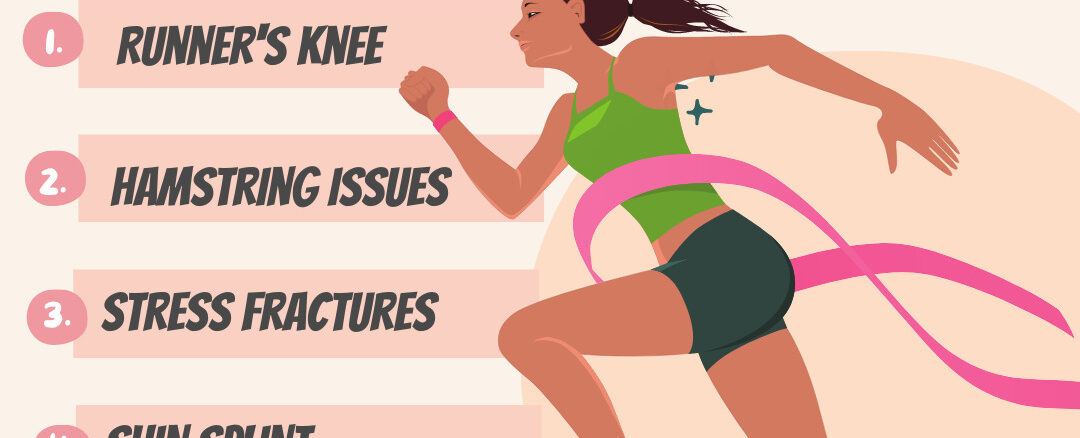Running is a great way to maintain fitness and stay in shape. It helps you to burn calories, relieve stress, and enjoy the outdoors. Despite several benefits, there is always a chance of injury among runners. Repetitive running can cause severe damage to your muscles, bones, and tendons.
Also, if running injuries are left untreated, they can be worse and spread to other parts of the body. Overuse injuries of the foot, hip, knee, and lower leg are common in runners. You can prevent yourself from having an injury from running by getting awareness about the running injuries. So, today in this blog, we’ll talk about the most common sports injuries among runners, how to treat them, and how to avoid them. Let’s begin!
Runner’s Knee
Patellofemoral pain syndrome or simply runner’s knee is one of the most common sports injuries among runners. Healthcare professionals have been unable to identify the cause of this injury despite its popularity.
A person affected by the runner’s knee experiences a dull ache in the knee, usually at the front. This sensation is particularly common in people when kneeling, walking up or down stairs, or squatting. Patients who sit for long amounts of time with their knees bent are also at risk of developing pain.
Patellofemoral pain syndrome is usually caused by overuse, which is especially prevalent among runners. People who have had past knee injuries are also prone to it. For example, fractures and dislocations can make runners more vulnerable to this injury. This injury could also occur after the surgery. Regardless of these circumstances, it is critical to get a diagnosis as soon as possible.
While there is no complete cure for this condition, there are ways to ease the treatment.
- Icing, wrapping or resting the knee
- Elevating the leg while lying down or sitting
- Regular stretching
- Physical therapy
Hamstring Issues
Runners, both professional and non-professional, can develop strained, pulled, or torn hamstrings. If your hamstrings are excessively flexible, weak, or tired, you are more prone to this injury.
Runners with powerful quads may also experience hamstring difficulties on occasion. Failure to warm-up can also be a contributing factor.
Acute injuries, in which runners experience sudden, severe pain, necessitate months of rest in order to heal properly. On the other hand, People who have developed this injury over time may benefit from light jogging– but the intensity must be reduced.
In general, resting should help this process move along quickly. Stretching (under the supervision of an orthopaedic doctor) is an important part of the rehabilitation process.
Stress Fractures
Stress fractures are another type of sports injury that affect runners, although they are not specific to one part of the body. Stress fractures, as the name suggests, occur due to the stress that this exercise places on the bones. Runners who exercise too frequently, for too long, or at too high intensity are usually affected by this condition.
Allowing your bones to heal from the stress of intensive activity is critical. Women are more likely than males to develop this type of sports injury. People who have been running for a long time are also less prone to suffer from this injury.
Continuing to run after a stress fracture could worsen the condition. For proper and long-term healing, this sports injury usually necessitates 8-16 weeks of rest. Weight training regularly may help you maintain your bone density and avoid injury in the future.
Shin Splints
Shin splints are a painful condition that affects the tibia, or shin bone. In many cases, inexperienced runners develop shin splints who are not properly trained. The most common patients are those runners who drastically increase the intensity of their training or who return to jogging after a long period of inactivity. Improper footwear, which can place unnecessary stress on the feet, can also induce (or worsen) shin splints.
Runners who encounter this ache should immediately reduce their amount of activity to avoid further injuries. They should then reduce their running intensity to a more comfortable distance or speed.
Recovery from shin splints might be helped by stabilising the various parts of the body engaged in running. For example, an ankle brace relieves some of the stress.
Ankle Sprain
Sprained ankles are a common sports injury among runners. Any sportsman who performs an activity that requires quick, precise movements is prone to this injury. Ankle sprains are common among runners of all levels of activity because running is one of the most motion-heavy sports.
When the ligaments in the ankle are moved out of their usual position, they stretch and tear. A twist, an awkward landing, running in a region with uneven surfaces, or any other movement that causes your ankle to be pulled into an unusual posture can cause this condition.
Ankle sprains are more common in people who are just starting to engage in physical exercise because their muscles are not as strong. Running in an outdoor location may potentially raise your chances of suffering from this sports injury. Patients who have sprained their ankles before are more prone to do so again.
It’s critical to apply ice and relax after an injury has occurred. Swelling can then be reduced by compressing it using an elastic bandage. Finally, elevating can help in fluid drainage. With specialized physical therapy treatment, an orthopedic specialist can assist patients in overcoming this condition. Stretching, mild workouts and other methods are frequently used to improve this. An arthroscopic operation may be used to address really severe ankle pain.
Click here to contact for more information


